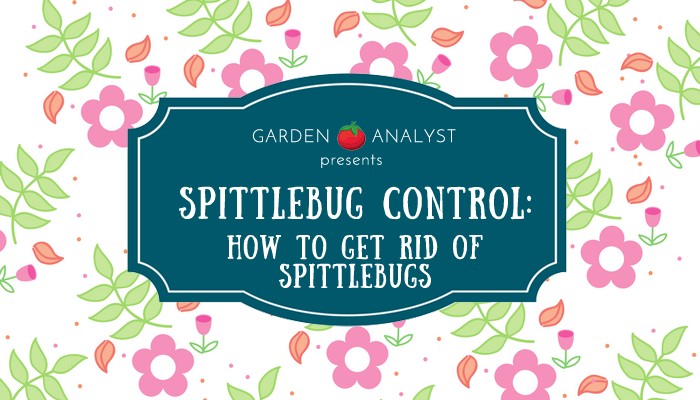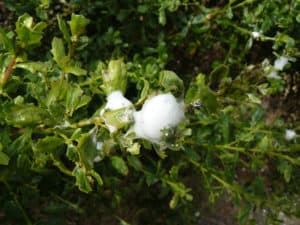If you have noticed a strange foam that resembles a spittle, on your lawn or your garden plants and flowers, you may have a problem with pests known as spittlebugs. Fortunately, these bugs are easy to target and control. Learn how to get rid of spittlebugs and destroy them without damaging your grass and plants, and how to prevent them appearing in the first place.


What are Spittlebugs?
Spittlebugs, also called froghoppers, are sucking insects that belong to the superfamily Cercopidae. They spread widely across North America. Some of the well-known spittlebugs are Two-lined spittlebug, Dogwood, Meadow, Saratoga or Diamondback spittlebug. The two-lined spittlebug (Prosapia bicinta) is the most common spittlebug in the United States.
The name spittlebug comes from the spittle-like froth they produce. But, that is not really a spittle – it is a product of the plant’s sap they feed on and they release it from the back parts of their bodies. The foam protects them from natural enemies and predators, extreme temperatures and helps them to remain well hydrated.
The foam is produced by immature spittlebugs, called nymphs. Spittlebugs lay their eggs twice a year – once in the fall and the second time in the summer. The spittlebug lays eggs in the fall and eggs overwinter in plant debris or bellow the plant stem. Nymphs hatch when the spring arrives, and within a month they become adults. Adult spittlebug lives for about 3 weeks and lays eggs for the last 2 weeks. Within several weeks, those eggs become adults too.
With more than 23,000 species, spittlebugs range from brown to black with some having two distinct yellow lines across their backs. They are small insects, about 1/3 of an inch when adult.
Moist and humid environment suits spittlebugs. These pests are usually in connection with thatch – a layer of living and decaying organic material that occurs between the green portion of the grass and the soil. Thatch makes a favorable environment for spittlebugs by trapping excessive moisture.
Junipers and pine trees are spittlebugs’ favorites, but they can be found on strawberries, roses and various ornamental plants such as hollies, asters and morning glory. Their favorite lawn grasses are Centipede, Bermuda St. Augustine, and Zoysiagrass. Spittlebug nymphs sometimes feed on corn.
First Signs of Spittlebug Presence
You can locate spittlebug nymph very easily – it thrives inside the foam. It is more difficult to find adults since they are quite mobile and fast. Besides, they can jump from plant to plant, and it’s been said that some species can jump up to 70 cm vertically.
But, their presence alter the host plant so you just have to look up for the possible changes on your plants and grass.
When they attack a plant, check the underside of the leaves, since change is not usually seen from above. If you find a pale mottling on the leaves, it could be the sign that spittlebug is sucking out the juices from the host plant.
When spittlebugs attack your grass and lawn, the grass gradually turns yellow and withers. When there is a severe infestation, the lawn grass eventually turns brown and dies.
Learn How To Control or Kill Spittlebugs
Although spittlebugs do feed on plant sap, they do very little damage to plants. The spittlebug populations are usually small, but if large populations are present they can cause heavy infestations and damage your plants and lawn grass.
You can get rid of these pests in three ways – prevention, green control and chemical treatment, but always consider prevention and cultural methods first.
Preventing Spittlebugs
Prevention means you should remove weeds that are attractive for the spittlebugs and eliminate the conditions that favor them. Clean your garden and lawn in the fall, removing all plant debris and decaying organic material. This way you will remove their ideal environment for egg laying, reducing egg population.
Remove thatch from your lawn if present. That means you have to be careful and not to overwater your grass. Make sure your soil has a good drainage since the poor drainage tends to accumulate thatch fast. You can remove thatch with dethatcher – a vertical mower.
Physically remove the adult spittlebug when it’s possible. If you spot them, just use a hose end sprayer and remove them easily with a blast of water.
Organic Pesticides
Organic pesticides are the greenest solution to the pest problem. They are as efficient and effective as chemical pesticides, but less harmful. Try to mix your own organic pesticides, but be careful with them and follow the given instructions.
- Mix 1/2 cup of hot peppers, 6 cloves garlic and two cups of water into a puree. Leave it for 24 hours. Add the liquid soap without bleach (it will help pesticide stick to the foliage and thus remain active longer). Spray all the part of the plant and remove the foam.
- Nettle (Urtica dioica) is a herbaceous perennial flowering plant, with stinging leaves and stems. Mix 1.5 pounds of nettles and soak in 2 gallons of water. Remove nettle leaves after 24 hours and use remaining liquid as pesticide – dilute one part of it in 20 parts of water for foliage spraying. To use in the soil, use one part in five to ten parts of water.
- Use neem oil or a citrus based are natural insect repellents. Spray attacked plants and grass with the mix of one once of neem oil with a gallon of water and one teaspoon of soap.
Chemical Control
Chemical pesticides should only be used as a last resort after all other control measures have been used. Avoid them as long as possible. Chemicals can damage the precious bacteria, microbes, and worms that actually decompose the thatch layer. If you kill them, the thatch will decompose slowly, providing an ideal environment for pests.
But, if the spittlebug population is large enough to actually kill the lawn, chemical control may be needed. Pesticide chemicals recommended for spittlebug control are:
- Lambda-cyhalothrin
- Bifenthrin
- Pyrethroid
- Carbaryl
- Cyfluthrin
- Deltamethrin
- Permethrin
- Imidacloprid + beta-cyfluthrin
Always check the label for the manufacturer’s recommended instructions and follow them strictly. One or two application is needed and results are shown in 1-2 days.